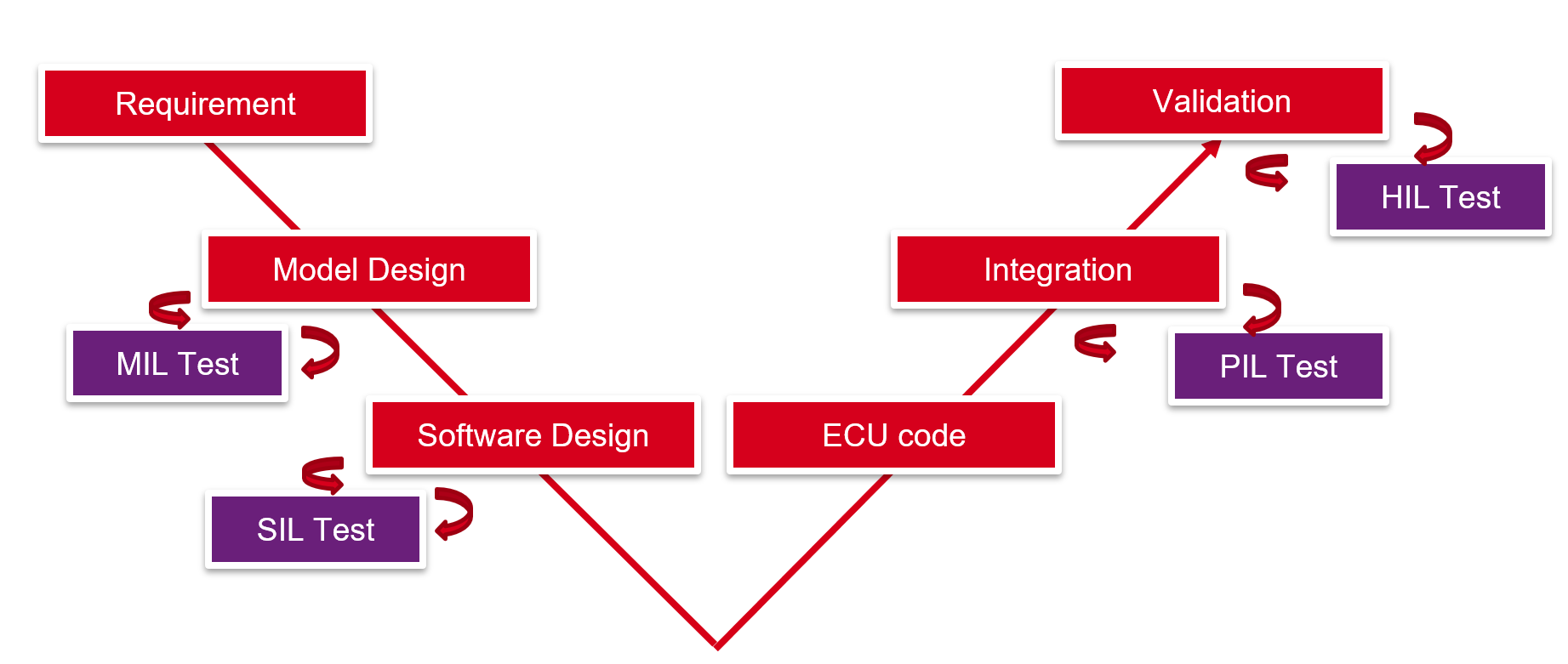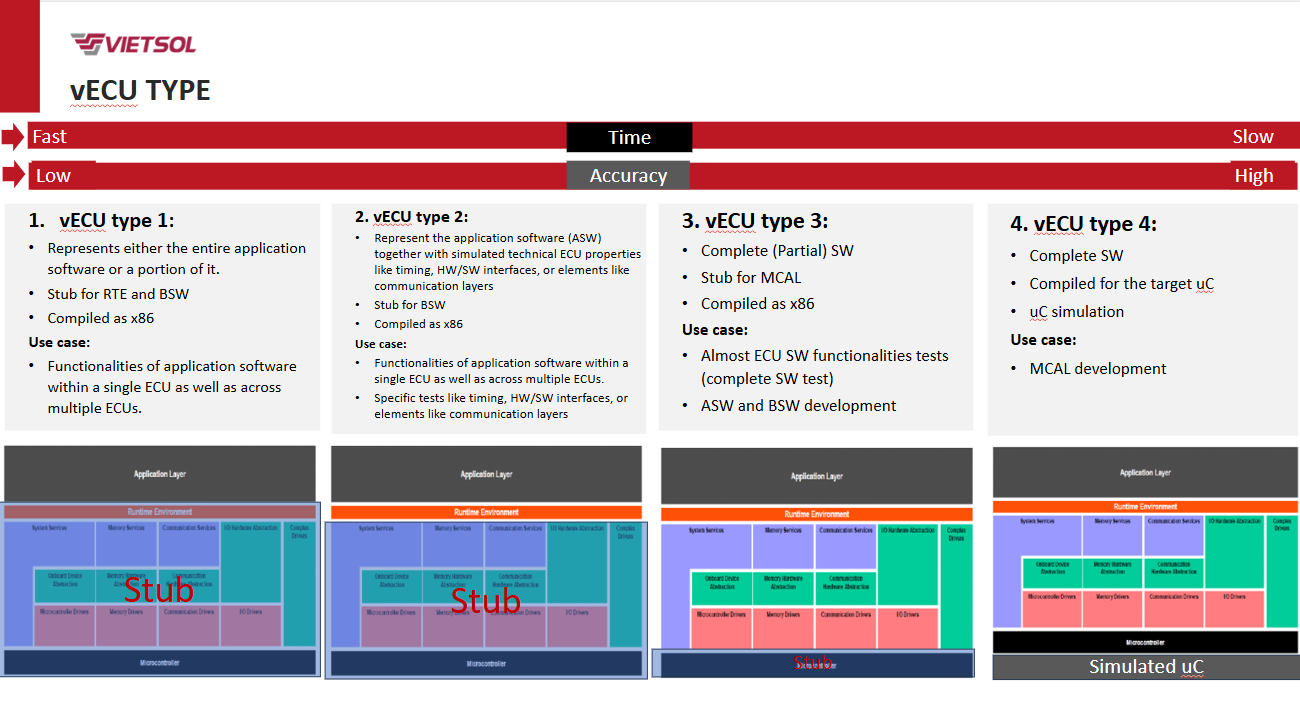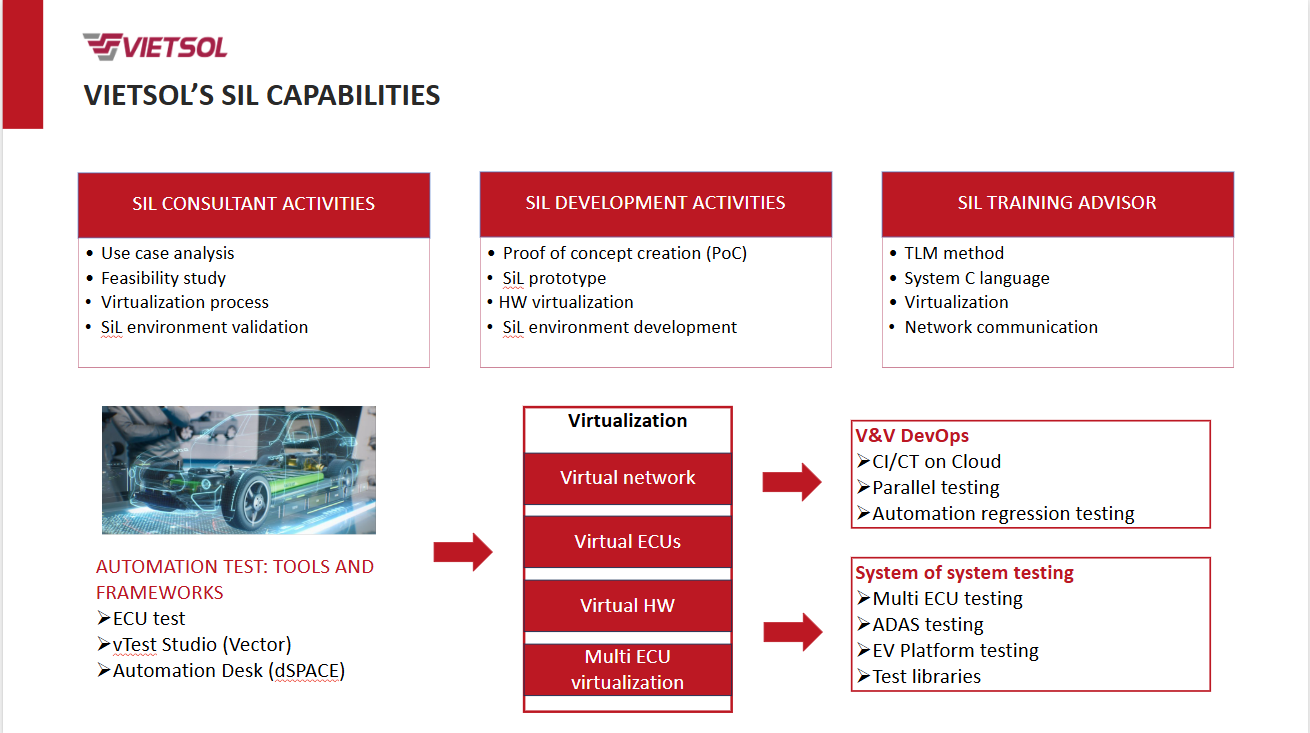Software in the Loop is not just a testing method — it’s becoming a strategic validation standard in global automotive engineering.
Introduction: Understanding Software-in-the-Loop (SiL) for Automotive Engineering
As vehicles evolve into complex, software-defined systems, ensuring robust, scalable, and early-stage validation of embedded control software is essential. Vietsol is at the forefront of this transformation, offering accessible SiL workflows that match global standards while addressing the specific needs of Vietnamese OEMs, Tier 1s, and innovators.
What is SiL and Why It Matters
Modern vehicles are not just mechanical machines — they are computational platforms on wheels. The increasing complexity of embedded software within Electronic Control Units (ECUs) has introduced new challenges: faster release cycles, heightened safety demands, and intricate system interactions.
Software-in-the-Loop (SiL) addresses these challenges by enabling engineers to test and validate compiled software in a virtual environment that mimics real-world behavior — before the hardware is even available.
According to a 2023 McKinsey report, software-related recalls account for nearly 40% of vehicle recalls globally, underscoring the need for earlier and more effective validation techniques (source).
Key Benefits:
- Earlier design flaw detection
- Reduced dependency on costly prototypes
- Seamless integration into CI/CD cycles
SiL in the Validation Flow: From MiL to SiL to HIL
Software validation progresses through distinct stages:
- Model-in-the-Loop (MiL): High-level model simulation (e.g., Simulink logic)
- Software-in-the-Loop (SiL): Compiled code tested in a virtual environment
- Hardware-in-the-Loop (HIL): Final-stage testing using real-time hardware

SiL strikes the balance between MiL’s speed and HIL’s realism — with lower cost and better scalability.
Vietsol’s Role in Advancing SiL in Vietnam’s Automotive Sector
As one of the few technology vendors currently offering Software-in-the-Loop (SiL) services in Vietnam, Vietsol plays a pioneering role in bridging the gap between global validation standards and local automotive needs. Our efforts are tailored not only to support innovation but also to democratize access to advanced simulation-based validation frameworks.
Strategic Integration of Global Toolchains
Vietsol supports virtual validation by integrating:
- Vector DYNA4: Advanced vehicle dynamics and sensor simulation
- Polarion and Teamcenter: Lifecycle, compliance, and traceability tools
These integrations enable:
- Multidomain co-simulation
- Streamlined data flow from design to validation
- CI/CD and version control compatibility (Git, Jenkins, GitLab)
According to a 2022 Deloitte study, automotive companies integrating toolchains for virtual testing saw a 30% reduction in development time and a 20% cost savings (source).
Software in the Loop Use Cases in Vietnamese Automotive Development
Comparative Overview: NXP MCUs vs. TDA4 SoC
To better contextualize the applications Vietsol is exploring with Software-in-the-Loop (SiL), the table below highlights the key features of two prominent hardware platforms: NXP MCUs and Texas Instruments TDA4 SoC.
| Feature | NXP S32K / MC56F (for BMS) | TI TDA4VM (for ADAS) |
| Target Application | Battery Management Systems | ADAS (Autonomous Driving, Perception Layer) |
| Architecture | ARM Cortex-M (S32K), DSC (MC56F) | ARM Cortex-A72, DSPs, Deep Learning Accelerators |
| Safety Compliance | ISO 26262 (ASIL B/C) | ISO 26262 (ASIL D capable) |
| Simulation in SiL | At AUTOSAR architecture, simulate MCAL layer to support cell balancing, thermal control SWC | TDA4 hardware real-time emulation
|
| Toolchain Support | Matlab/Simulink, Battery Emulator, S32DS, Canoe | TI Processor SDK (RTOS/LINUX), TIOVX (OpenVX) For Computer Vision App |
| Power Profile | Ultra-low power for battery-powered environments | High-performance computing with efficient power use |
| Availability in Vietnam Market | Widely supported by local vendors | Less commonly available, higher integration required |
This comparison helps engineers and system integrators select the appropriate validation strategy and hardware abstraction approach depending on the complexity of the system under test.
While specific client use cases are confidential, Vietsol has explored SiL in contexts such as:
- Battery Management Systems (BMS) using NXP MCUs — NXP’s S32K and MC56F platforms are widely used for BMS in EVs due to their low power consumption, robust peripheral set, and ISO 26262 compliance. In Vietsol’s experimental SiL setups, we use compiled control software interacting with cell-balancing and thermal management plant models to simulate critical failure modes and ensure control stability under fast charge/discharge conditions (source)
- TDA4 SoC virtualization for ADAS software testing — The TDA4VM from Texas Instruments is a widely adopted AI processor in ADAS ECUs, offering integrated ISP, DSP, and deep learning accelerators. Vietsol has constructed early-stage software tests with virtual TDA4 targets by real-time emulated hardware. Software defects will be detected and fixed early in this stage before performing integration testing with real hardware. From there, the development speed and quality of the software will be significantly improved.
Rather than focusing solely on ADAS functions, Vietsol promotes SiL as a general-purpose tool for validating algorithms under various runtime conditions.
Vietnam’s growing EV sector—with over 30,000 EVs registered in 2023—amplifies the demand for fast, flexible validation tools like SiL (source).
ECU Virtualization on Windows: Democratizing SiL
Vietsol recognizes that one of the key barriers to entry for SiL adoption in Vietnam is the limited access to expensive embedded hardware. By enabling full ECU virtualization on common Windows-based development platforms, Vietsol empowers engineering teams to conduct meaningful validation without waiting for target hardware — streamlining the R&D cycle for startups, universities, and mid-sized suppliers alike.

How It Works:
- Control logic (from Simulink or C code) is compiled into dynamic libraries
- vECU communicates with simulated plants in a Windows-native environment
- Test engineers inject signals, observe behavior, and capture logs using IDEs like Visual Studio or MATLAB
Benefits:
- No embedded hardware required in early stages
- Automated test runs via Jenkins or GitLab
- Ideal for startups, academia, and distributed teams
This workflow enables budget-conscious organizations to execute full-scale virtual validation on standard workstations — democratizing innovation.
Real-World Benefits for OEMs and Tier 1 Suppliers
Software in the Loop enables these benefits to materialize earlier in the development lifecycle/ SiL workflows are no longer just tools for validation — they are strategic differentiators for organizations pursuing rapid innovation. In Vietnam’s evolving automotive ecosystem, the ability to virtually validate embedded software opens up new levels of agility, system quality, and time-to-market competitiveness.
Accelerating Time-to-Market
SiL supports:
- Early integration and calibration before ECU delivery
- Parallel development across teams
- Cost savings from reduced HIL usage
Enabling Agile, Collaborative Development
By virtualizing the validation process, SiL allows:
- Functional teams to work in parallel
- Global collaboration on shared virtual assets
- Digital twin alignment with cloud-based testing platforms
A 2021 Capgemini survey shows that 72% of automotive executives believe virtual validation technologies like SiL will become the norm in development workflows (source).
Vietsol’s SiL framework bridges the gap between:
- System architects defining functions
- Developers coding embedded logic
- Test engineers validating against requirements
At its core, Software in the Loop empowers faster, more collaborative development — from concept to code.
The Future: SiL as a Strategic Enabler in Vietnam
Vietnam’s path to becoming an innovation hub requires more than assembly lines — it needs software and validation capabilities.

Software in the Loop empowers:
- Domestic development of IP for smart mobility
- Global collaboration with Tier 1 and OEM partners
- Scalable adoption of MBSE and test automation
Vietsol plays a vital role through:
- R&D partnerships
- Workforce training
- Accessible toolchain deployments
Frequently Asked Questions (FAQs)
What are Vector DYNA4, Polarion, and Teamcenter?
- Vector DYNA4 is a virtual driving simulation tool used for vehicle dynamics, ADAS/AD testing, and sensor environment emulation in SiL and HiL workflows. It enables engineers to test perception and control systems using realistic synthetic scenarios.
- Polarion is a web-based application lifecycle management (ALM) platform developed by Siemens. It helps teams manage requirements, track traceability, and ensure compliance with ISO 26262 and ASPICE.
- Teamcenter, also by Siemens, is a product lifecycle management (PLM) solution that centralizes design data, project planning, and process documentation—improving cross-team collaboration and digital continuity across engineering disciplines.
What is the difference between MiL, SiL, and HIL?
- MiL: Tests model-level logic
- SiL: Runs compiled control code on a PC
- HIL: Tests code on hardware connected to real-time simulators
Can SiL be integrated into DevOps or CI/CD pipelines?
Yes. Vietsol supports Jenkins, GitLab, and Azure CI integrations for SiL.
Does SiL only apply to safety-critical systems?
No. It applies to infotainment, diagnostics, energy systems, and more.
What support does Vietsol provide for SiL?
- vECU development
- Sensor/plant modeling
- SiL test framework setup
- On-site/remote team training
Conclusion: Smart Validation Starts with Software in the Loop
Software in the Loop is transforming automotive software validation. It shortens cycles, improves collaboration, and raises software quality. Through Vietsol’s accessible approach, Vietnam is shaping its future as a true contributor in the global smart mobility ecosystem.
Contributors
Thang Nguyen Duc is currently the Team Leader of the Software-in-the-Loop (SiL) and Software Development groups at Vietsol Co., Ltd. He graduated from the University of Science and Technology with a major in Control Engineering and Automation.
With over three years of experience in SiL and automotive software development, he has contributed to a wide range of projects in the automotive domain. His work spans from developing in-vehicle infotainment (IVI) systems — including media and navigation — to building virtual ECUs from type 1 to type 4, such as the Virtual BMS NXP and TI TDA4 Emulator.
He is experienced in platforms such as Automotive Grade Linux, Automotive Android, and AUTOSAR OS, and is well-versed in software development processes aligned with the ASPICE standard.
With a strong foundation in systems thinking and technical leadership, he is committed to delivering high-quality software solutions for next-generation automotive systems.
Quốc Khánh Hoa is a multi-domain Project Manager at Vietsol Co., Ltd., where he has been actively contributing across several key initiatives, including Software-Defined Vehicles (SDVs), Software-in-the-Loop (SiL), and AI/ML for smart manufacturing.
With a solid background in embedded systems and control engineering, Khanh has worked extensively with cross-functional teams — from system architecture to test automation — helping Vietsol drive smarter, simulation-driven development workflows.
More recently, Khanh leads projects in AI/ML, where he promotes the concept of Modular AI Agents — domain-specific AI blocks that act like a virtual expert team in manufacturing environments. He has presented these ideas at global tech stages such as Automechanika and Automotive World Japan.
Khanh is driven by the belief that Vietnam can become a leader in simulation-based engineering — and continues to mentor teams to adopt MBSE, SiL, and intelligent automation as pillars for next-generation automotive innovation.

 Tiếng Việt
Tiếng Việt
RELATED NEWS
Security Testing: The Essential Role in Automotive Cybersecurity
The explosive rise of interconnected automotive technologies is transforming the driving experience like never before. From seamless keyless entry and smartphone apps that control in-vehicle functions, to Vehicle-to-Everything (V2X) systems that enable cars to communicate with infrastructure, other vehicles, and real-time data sources — today’s vehicles are smarter, safer, and...
What are Driver and Occupant Monitoring Systems (DMS/OMS)?
In the automotive industry, many safety incidents originate from human factors inside the vehicle cabin, such as driver distraction, drowsiness, or passengers not wearing seat belts. As a result, in-cabin monitoring and proactive responses to abnormal behaviors are becoming increasingly essential. The Driver Monitoring System (DMS) and Occupant Monitoring System...
Welcoming Didier Chenneveau as Senior Strategic Advisor to Vietsol – Driving Global Strategy in Edge AI and Mobility
Vietsol is proud to announce the appointment of Mr. Didier Chenneveau as Senior Strategic Advisor, marking a significant milestone in our mission to become a globally competitive engineering and technology company. With over 35 years of global leadership experience, Didier will play a key role in shaping Vietsol’s international strategy,...